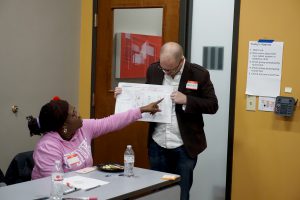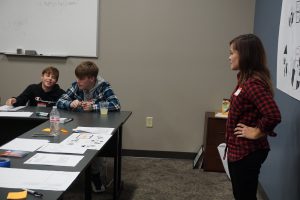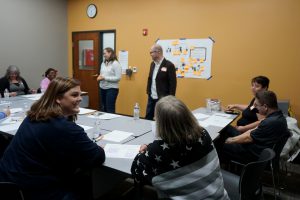 Plenty of experimentation can happen outside a traditional laboratory environment, a theory that has been tested and proven to be true by the Research Jam team. Research Jam is part of the Community Health Partnerships program of the Indiana Clinical and Translational Sciences Institute (CTSI), where community members, patients, providers and other researchers can collaborate in a unique setting.
Plenty of experimentation can happen outside a traditional laboratory environment, a theory that has been tested and proven to be true by the Research Jam team. Research Jam is part of the Community Health Partnerships program of the Indiana Clinical and Translational Sciences Institute (CTSI), where community members, patients, providers and other researchers can collaborate in a unique setting.
This month, families with children who have type 1 diabetes were invited to be part of a Jam about a tablet-based diabetes management system, which some doctors have already started utilizing in their clinics. Tamara Hannon, MD, MS, one of the doctors currently using the system, worked with the Research Jam team to develop this study. Through the Jam, Hannon hopes to improve adherence to medical recommendations (by both patients and providers), patient self-management and patient health outcomes.
“We find the experts in the problem space and work with them,” said Dustin Lynch, a visual communications designer with Research Jam. “If we’re studying diabetes, the experts are people living with diabetes. They help us explore the problem, then they help us create new solutions and recommendations that are more relevant to the people they serve.”
 The families met at the Central Indiana Community Foundation, first as a large group before dividing up into two smaller ones. The children – between the ages of 12-17 – who had been diagnosed with type 1 diabetes spent the evening in one room, while their parents and caregivers were in a different room. Each group did a similar ice-breaker game before starting the process of identifying “pain points” with the Child Health Improvement through Computer Automation (CHICA) platform.
The families met at the Central Indiana Community Foundation, first as a large group before dividing up into two smaller ones. The children – between the ages of 12-17 – who had been diagnosed with type 1 diabetes spent the evening in one room, while their parents and caregivers were in a different room. Each group did a similar ice-breaker game before starting the process of identifying “pain points” with the Child Health Improvement through Computer Automation (CHICA) platform.
“I thought it was great,” said Katie*, who is 14 years old. “I think they asked really relevant questions.”
Katie was diagnosed with type 1 diabetes when she was nine and enjoys going to her clinic visits, where she has used the CHICA diabetes management tool once before. Through CHICA, an adolescent answers questions about health issues that may be exacerbated by or may negatively impact the constant careful management required for their disease (like whether they have had suicidal thoughts or used a substance to get high in the last year) so that doctors are able to follow-up on these issues during the visit. There are CHICA modules for all kinds of different purposes and conditions, but this one is specifically for diabetes patients. While they were being used in clinics, researchers noticed there can be challenges, such as a parent filling out the survey instead of the child or the doctor not receiving the survey answers in a timely fashion.

After a brainstorming session about the “pain points,” parents and children were split up into groups of two or three. Each small group was given markers to draw creative solutions to the challenges they came up with on oversized pieces of paper, which they presented to everyone else.
“I did not expect to come here and think this was going to be fun, but they had a really creative way of breaking down the stiffness of the group,” said Jane*, who is Katie’s mother. “I thought it was super fun.”
For this particular Jam, the participants were encouraged to create solutions, but other Jams are used to explore issues more broadly or test potential solutions instead. Not every Research Jam includes drawing, but each one encourages the people involved to think creatively and collaboratively. In some cases when researchers can’t meet up with groups in person, Jams might also include journaling or workbooks to help participants come up with fresh insights.
“Working with patients and community members is always successful in allowing us to learn new things and create something that can be tried,” said Lynch. “I think we’re always successful in generating information that our researcher client has not seen before.”
Other CTSA’s across the county have methods for engaging patients in research, like Research Jam, but Lynch says what makes the Indiana CTSI unique is the approach in using human-centered design research. By involving people who are directly impacted by each subject they are studying, they can make their research more specific to the problem at hand, as opposed to having a standing patient advisory board.
Find out more about Research Jam here.
*Name changed to protect research study anonymity
